Semi-Physical Simulation Method for Stellar Maps with Color Temperature Information
Abstract
1. Introduction
2. Framework for Semi-Physical Simulations of Stellar Maps with Color Temperature Information
3. Algorithm for Stellar Map Simulation with Color Temperature Information
3.1. Stellar Spectral Type to RGB Triple-Color Conversion
3.2. Color Temperature Deviation Calibration
3.3. Algorithm for Generating Stellar Maps with Color Temperature Information
4. Experimentation and Discussion
4.1. Experimental Platform and Design
4.2. Experimental Results of the Pre-Experimental Phase
4.2.1. Stellar Spectral Type to RGB Three-Color Conversion
4.2.2. Color Temperature Deviation Calibration
4.3. Experimental Results of the Validation Experiment Phase
4.3.1. Stellar Map Image Generation with Color Temperature Information
4.3.2. Semi-Physical Simulation of Stellar Maps with Color Temperature Information
4.4. Discussion and Comparison
5. Discussion and Conclusions
- The polynomial number of fits of the stellar spectral type to blackbody color temperature ranged from 3 to 37 correlation coefficients above 0.99, with the 22nd polynomial fit being the best. The standard deviation of the simulated color difference for the 24 standard colors was reduced by a factor of 1.6 after calibration using a 24-color standard color card.
- The maximum deviation of the stellar spectral type simulations of the four stellar maps after color temperature bias calibration was better than 9, and the average deviation was better than 6.55, which are both smaller than the metric scale of 10 minor spectral types within a major stellar spectral type.
- After the color temperature deviation calibration, the maximum deviation of the spectral type simulation of the four stellar maps was reduced by a factor of 1.89 to 2.11; the average deviation, by a factor of 1.29 to 1.73; and the standard deviation of the simulation deviation, by a factor of 1.58 to 2.53. These results indicate significant improvements in the limiting accuracy of the stellar map, the overall correctness of the simulation of color temperature information, as well as the dispersion.
Author Contributions
Funding
Data Availability Statement
Conflicts of Interest
References
- Zhang, W.; Yang, Y.; You, W. Autonomous navigation method and technology implementation of high-precision solar spectral velocity measurement. Sci. China Phys. Mech. Astron. 2022, 65, 289606. [Google Scholar] [CrossRef]
- Wang, Z.; Liu, S.; Sun, H. The influence of color temperature mismatch in star simulator on positioning accuracy and magnitude measurement by star sensor. J. Phys. Conf. Ser. 2021, 1, 2132. [Google Scholar] [CrossRef]
- Chaudhary, A.; Thapa, B.; Sodari, T. Distribution of Dust Color Temperature, Planck’s Function, and Dust Mass around PSR J1240-4124. J. Nepal Phys. Soc. 2022, 8, 88–95. [Google Scholar] [CrossRef]
- Huang, S.; Kang, Z.; Liu, J. Accuracy analysis of spectral velocimetry for the solar Doppler difference navigation. IEEE Access 2021, 9, 78075–78082. [Google Scholar] [CrossRef]
- Zhou, W.; Liu, Z.; Sun, Y. Bidirectional Littrow double grating interferometry for quadruple optical interpolation. Opt. Laser Technol. 2024, 175, 110751. [Google Scholar] [CrossRef]
- Niu, Y.; Wei, X.; Li, J. Fast and robust star identification using color ratio information. IEEE Sens. J. 2022, 22, 20401–20412. [Google Scholar] [CrossRef]
- Zhang, W. Astronomical spectral velocimetry navigation technology and application considerations. Navig. Control 2020, 19, 64–73. [Google Scholar]
- Wu, L.; Zhang, G.; Sun, G. Optical engine optimization for faint starlight simulation systems. Opt. Commun. 2020, 471, 125833. [Google Scholar] [CrossRef]
- Schulz, V.H.; Marcelino, G.M.; Seman, L.O. Universal verification platform and star simulator for fast star tracker design. Sensors 2021, 21, 907. [Google Scholar] [CrossRef]
- Teague, S.; Chahl, J. Imagery synthesis for drone celestial navigation simulation. Drones 2022, 6, 207. [Google Scholar] [CrossRef]
- Trivellin, N.; Barbisan, D.; Ferretti, M. Adaptive multi-wavelength LED star simulator for space life studies. Proc. SPIE 2016, 9768, 976815. [Google Scholar] [CrossRef]
- Jing, J.L.; Guoyu, G.Y.Z.; Jian, J.Z. Spectral simulation method for calibration light source of transmissometers. Acta Opt. Sin. 2022, 42, 123–135. [Google Scholar] [CrossRef]
- Liu, Q.; Zhang, G.; Zhang, Y. Multi-color temperature and magnitude simulation for astronomical spectral velocity measurement. IEEE Access 2023, 11, 108104–108116. [Google Scholar] [CrossRef]
- Yun, Z.; Zhang, Y.; Liu, Q. Research on the simulation method of a BP neural network PID control for stellar spectrum. Opt. Express 2024, 32, 38879–38895. [Google Scholar] [CrossRef]
- Zhao, B.; Zhang, Y.; Yang, D. Playback method for dynamic star map simulation by fusing cosmic background radiation information. Measurement 2025, 242, 116086. [Google Scholar] [CrossRef]
- Sun, Q.; Niu, Z.; Li, Y.; Wang, Z. A Robust High-Accuracy Star Map Matching Algorithm for Dense Star Scenes. Remote Sens. 2024, 16, 2035. [Google Scholar] [CrossRef]
- Wang, H.; Yan, Z.; Mao, X.; Wang, B.; Liu, X.; Kang, W. A new high-precision star map simulation model and experimental verification. J. Mod. Opt. 2021, 68, 856–867. [Google Scholar] [CrossRef]
- Yang, S.; Zhang, Y.; Zhao, B. Simulation method for multi-source information fusion space target. Opt. Express 2024, 32, 21820–21836. [Google Scholar] [CrossRef] [PubMed]
- Bai, Y.; Li, J.; Zha, R. Catadioptric optical system design of 15-magnitude star sensor with large entrance pupil diameter. Sensors 2020, 20, 5501. [Google Scholar] [CrossRef]
- Hong, T.; Li, J.; Chu, D. Modulation approach of arbitrary linear polarization states of optical fields using single-beam coding for next-generation optical storage in glass. Opt. Laser Technol. 2023, 164, 109539. [Google Scholar] [CrossRef]
- Du, Z.; Sun, G.; Yang, S. Research on ultraviolet-visible composite optical target simulation technology. Opt. Express 2024, 32, 14541–14554. [Google Scholar] [CrossRef] [PubMed]
- Ma, M.; Niu, Y.; Gao, D.; Li, F.; Shi, G. Efficient Hyperspectral Video Reconstruction via Dual-Channel DMD Encoding. Remote Sens. 2025, 17, 190. [Google Scholar] [CrossRef]
- Liu, S.; Zhang, J.; Zhang, Y. Overall study of solar simulation optical system with large irradiated surface using free-form concentrator to improve uniformity. iScience 2023, 26, 107781. [Google Scholar] [CrossRef] [PubMed]
- Wu, L.; Wang, J.; Sheng, L. Research on polarization effect suppression method of weak starlight simulation device. Opt. Express 2024, 32, 39818–39830. [Google Scholar] [CrossRef]
- Gao, X.; Gan, X.; Chen, Y. Study of digital high-precision multi-star simulator for multi-magnitude output. Int. J. Control Autom. 2016, 9, 255–264. [Google Scholar] [CrossRef]
- Xu, Q.; Zhao, C.; Li, X. Stellar radiation modeling and image simulation for airborne daytime star sensor. In Proceedings of the IEEE International Conference on Signal and Image Processing (ICSIP), Beijing, China, 13–15 August 2016. [Google Scholar] [CrossRef]
- Saurova, K.; Shamro, A.; Alipbayev, K. Research of methods to improve the accuracy of the star sensor for global navigation satellite system technology. Eng. Sci. 2024, 33, 1351. [Google Scholar] [CrossRef]
- Bell, R.A.; Gustafsson, B. The effective temperatures and colours of G and K stars. Mon. Not. R. Astron. Soc. 1989, 236, 653–707. [Google Scholar] [CrossRef]
- Catalbas, M.C.; Bernard Kobav, M. Measurement of correlated color temperature from RGB images by deep regression model. Measurement 2022, 195, 111053. [Google Scholar] [CrossRef]
- Han, D.; Lee, M.; Jang, W. Two-color strip-patterned white OLEDs: Tunable color-temperature via pattern dimension control. Adv. Opt. Mater. 2022, 10, 2200456. [Google Scholar] [CrossRef]
- Tian, H.J.; Chen, T.; Hu, Y. Change of circadian effect with colour temperature and eye spectral transmittance at different ages. Lighting Res. Technol. 2021, 53, 41–53. [Google Scholar] [CrossRef]
- Chaity, M.D.; van Aardt, J. Exploring the Limits of Species Identification via a Convolutional Neural Network in a Complex Forest Scene through Simulated Imaging Spectroscopy. Remote Sens. 2024, 16, 498. [Google Scholar] [CrossRef]
- Harre, J.V.; Heller, R. Digital color codes of stars. Astron. Nachr. 2021, 342, 578–587. [Google Scholar] [CrossRef]
- Bateni, A.; Susnar, S.S.; Amirfazli, A. A high-accuracy polynomial fitting approach to determine contact angles. Colloids Surf. A Physicochem. Eng. Asp. 2003, 219, 215–231. [Google Scholar] [CrossRef]
- Vicente, E.G.; Matesanz, B.M.; Rodríguez-Rosa, M. Effect of correlated color temperature and S/P-ratio of LED light sources on reaction time in off-axis vision and mesopic lighting levels. LEUKOS 2023, 19, 4–15. [Google Scholar] [CrossRef]
- Burrow, J.A.; Jakachira, R.; Lemaster, G. Smartphone tristimulus colorimetry for skin-tone analysis at common pulse oximetry anatomical sites. arXiv 2024, arXiv:2411.13832. [Google Scholar] [CrossRef]
- Kahu, S.Y.; Raut, R.B.; Bhurchandi, K.M. Review and evaluation of color spaces for image/video compression. Color Res. Appl. 2019, 44, 8–33. [Google Scholar] [CrossRef]
- Galteri, L.; Ferrari, C.; Kollias, S. Color and texture analysis of textiles using image acquisition and spectral analysis in calibrated sphere imaging system-I. Electronics 2022, 11, 3887. [Google Scholar] [CrossRef]
- Bian, H.; Li, A.; Ma, H.; Wang, R. Navigation coordinate system. In Essentials of Navigation: A Guide for Marine Navigation; Springer Nature: Singapore, 2024; pp. 19–50. [Google Scholar] [CrossRef]
- Yuan, H.; Li, D.; Wang, J. A Robust Star Identification Algorithm Based on a Masked Distance Map. Remote Sens. 2022, 14, 4699. [Google Scholar] [CrossRef]
- Yi, H.; Yan, G. Preliminary research on color simulation of stars in a star simulator. Opto-Elec Eng. 2010, 37, 65–73. [Google Scholar] [CrossRef]
- Zhang, J.; Yu, S.; Wang, Y. Research on manufacturing technology of nanoimprinted grating. J. Manuf. Process. 2024, 131, 891–909. [Google Scholar] [CrossRef]
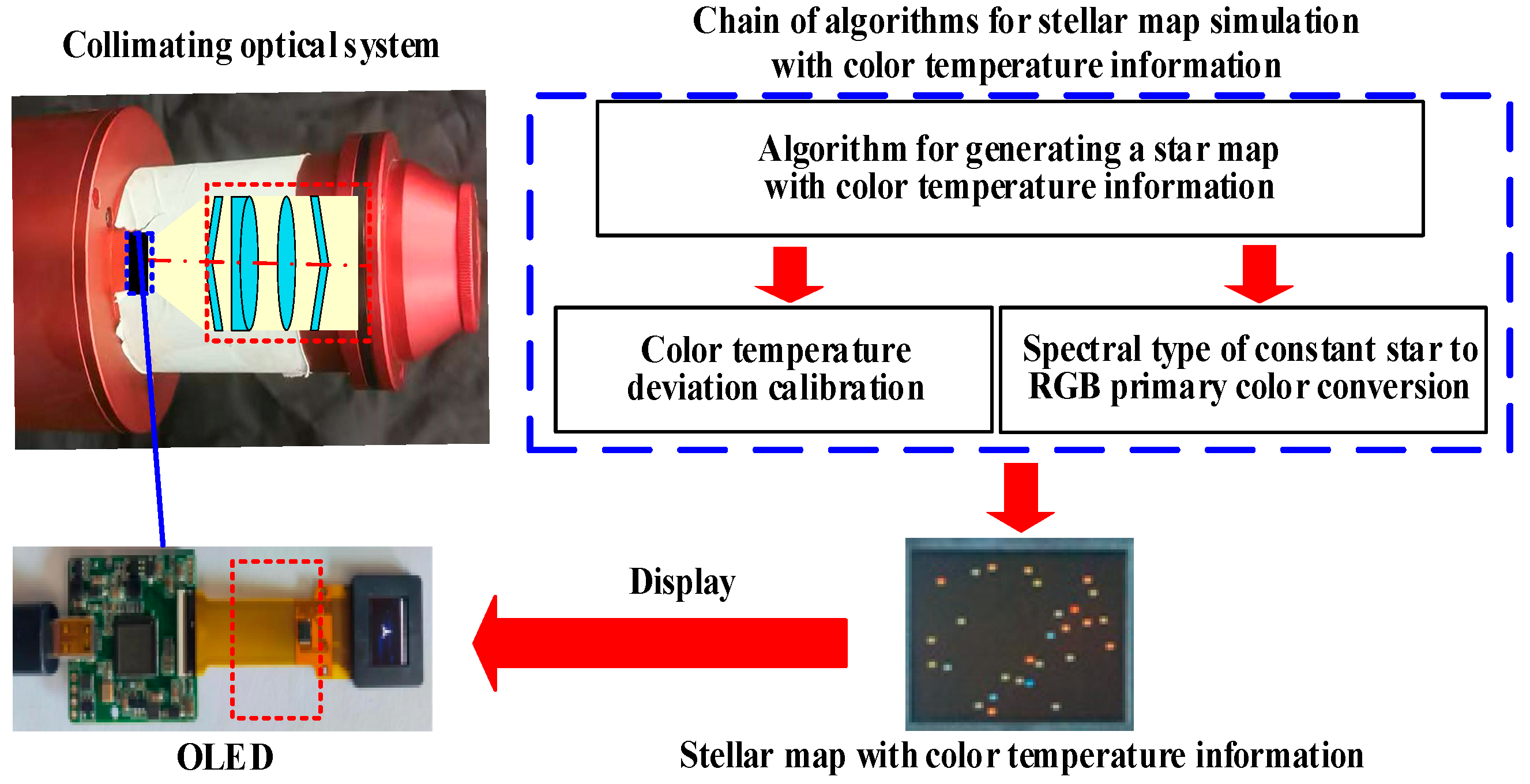

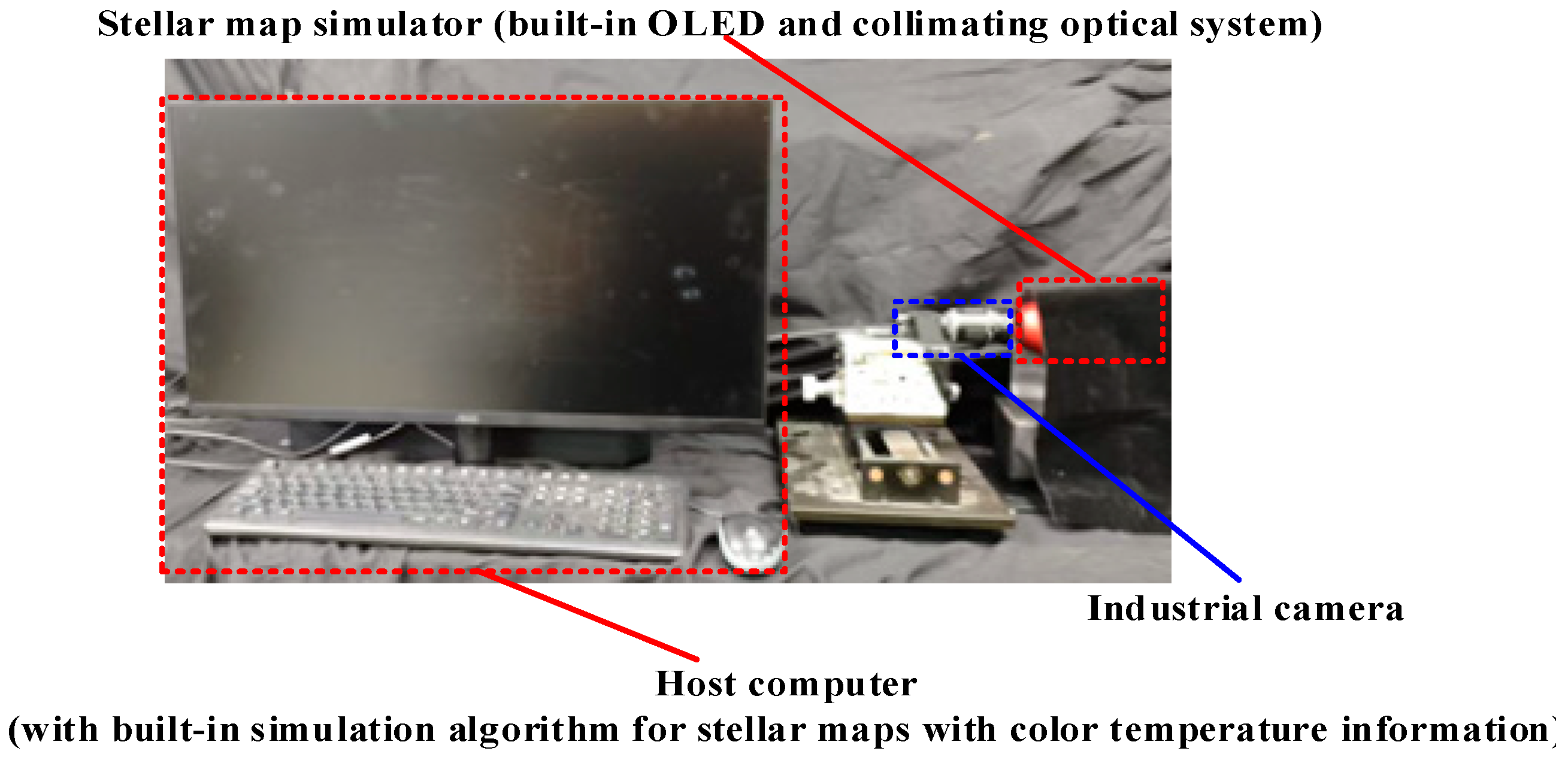
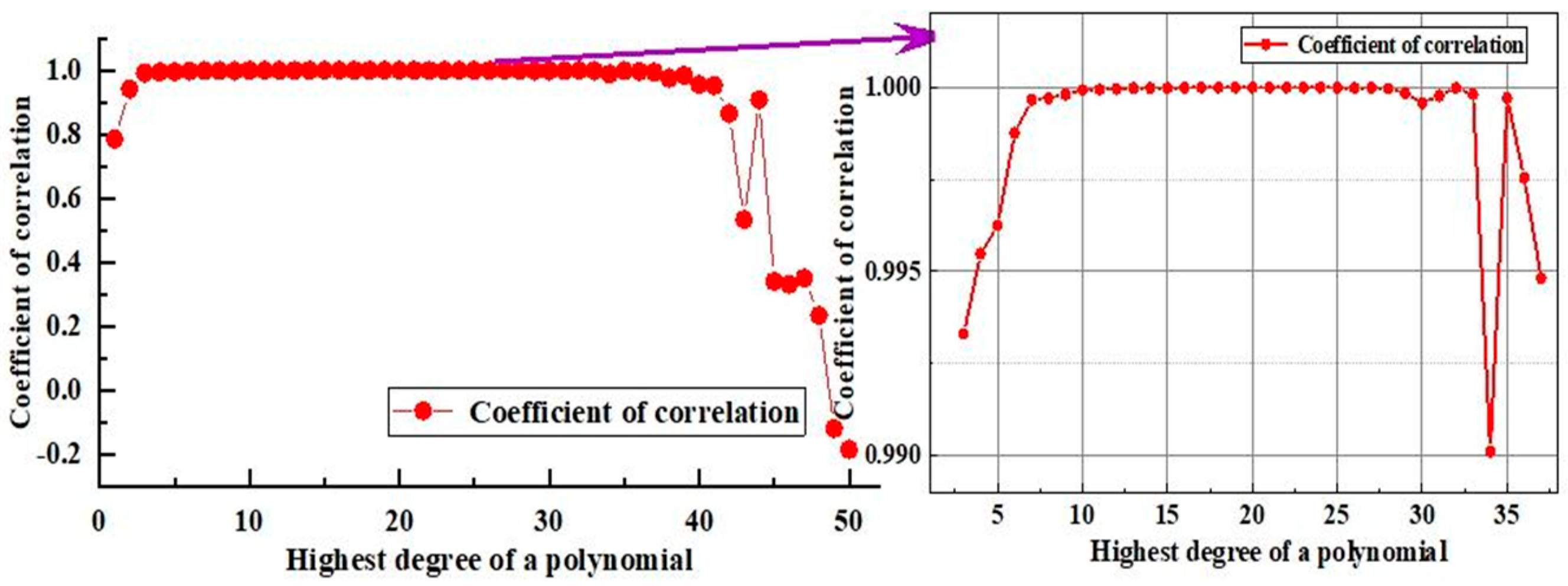

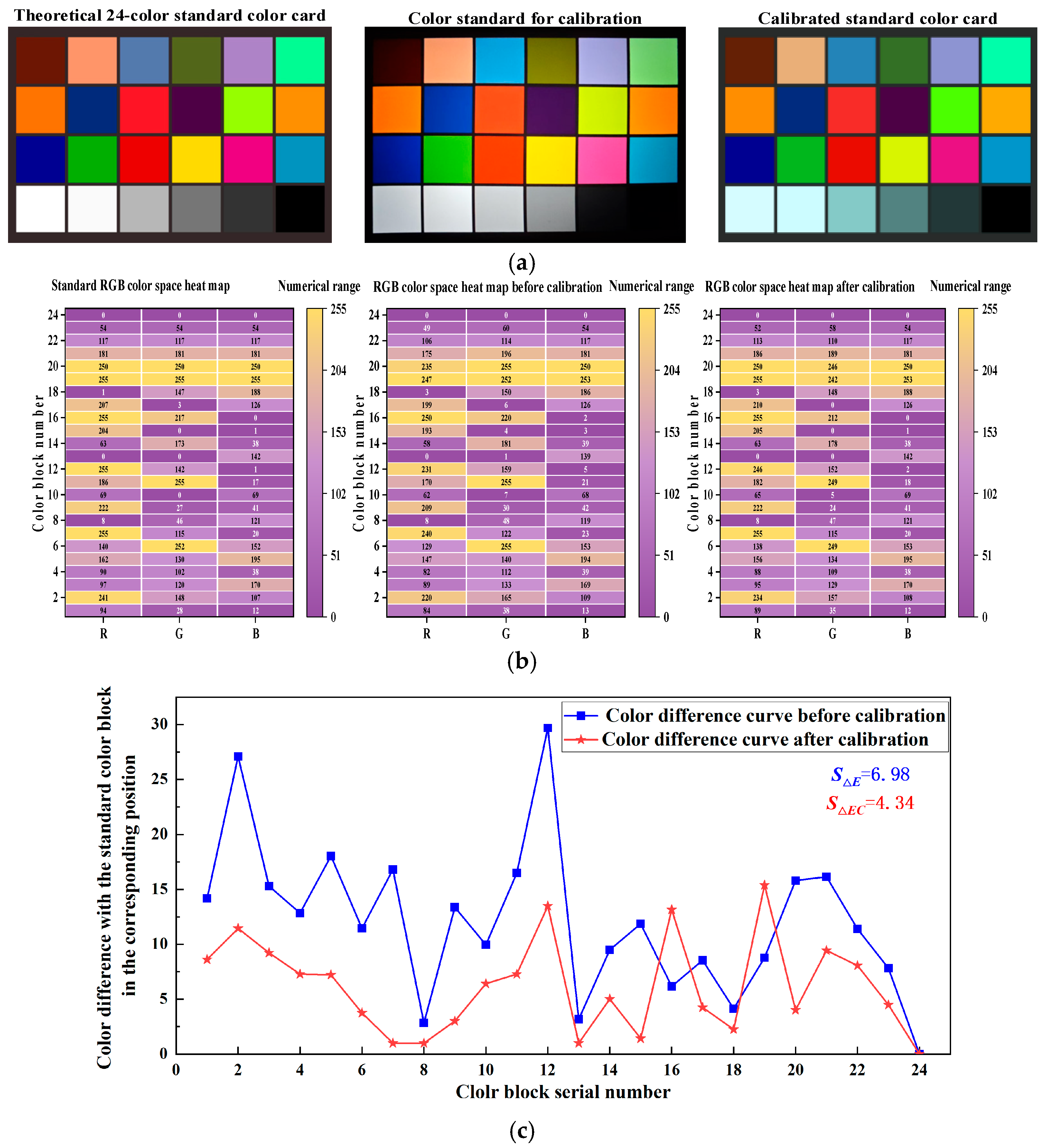

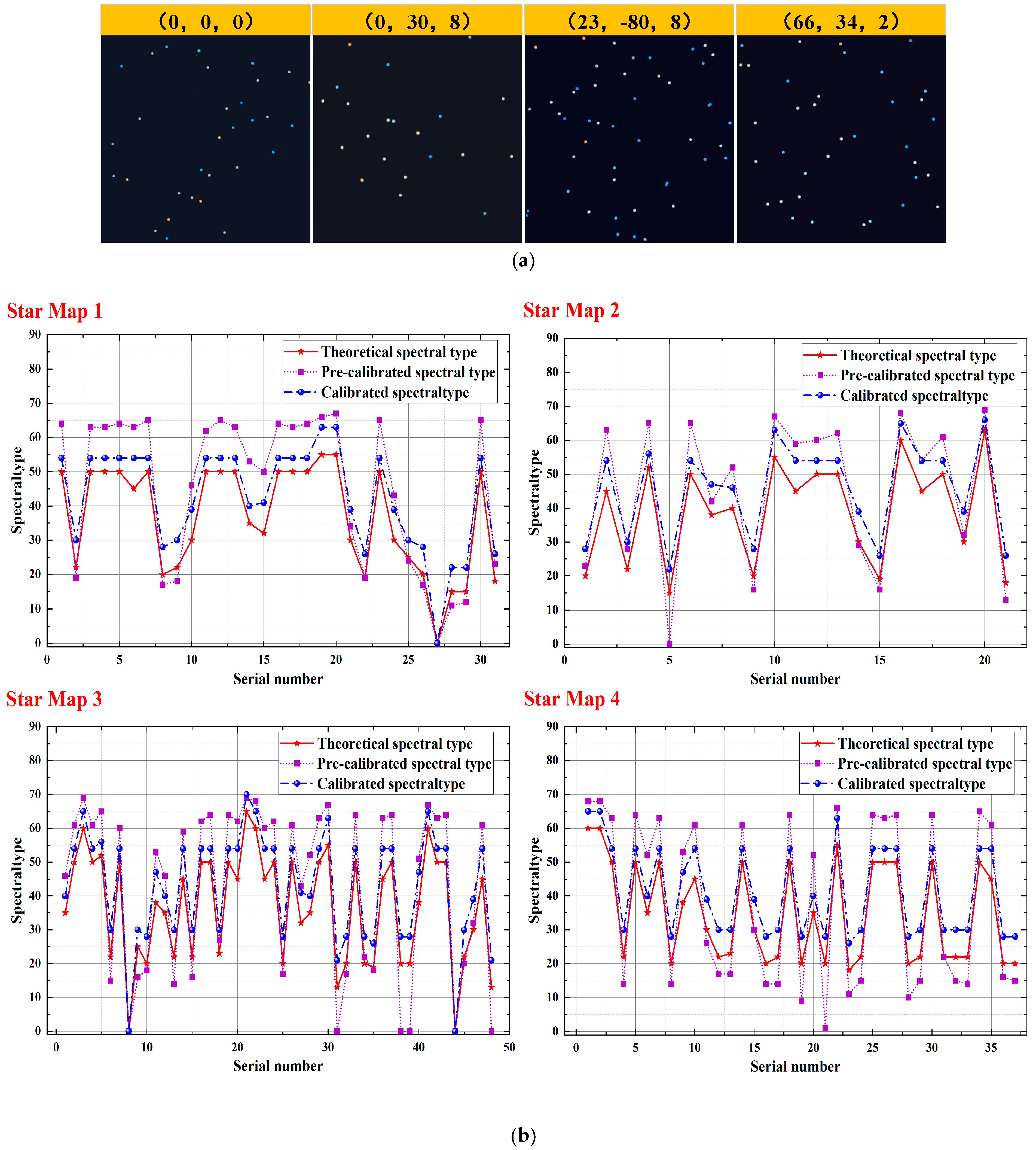
| Main Spectral Types | Encodings | Secondary Spectral Type | Encodings |
|---|---|---|---|
| TypO | 0 | Typ0 | 0 |
| TypB | 1 | Typ1 | 1 |
| TypA | 2 | Typ2 | 2 |
| TypF | 3 | Typ3 | 3 |
| TypG | 4 | Typ4 | 4 |
| TypK | 5 | Typ5 | 5 |
| TypM | 6 | Typ6 | 6 |
| - | - | Typ7 | 7 |
| - | - | Typ8 | 8 |
| - | - | Typ9 | 9 |
| Point | Name | Goal |
|---|---|---|
| Pre-experiment | Stellar spectral type to RGB triple-color conversion | The relationship between stellar spectral type and RGB triple-base color conversion is obtained |
| Color temperature deviation calibration | The combined color temperature deviations of the OLED devices and collimated optical systems are calibrated | |
| Verification experiment | Stellar map image generation with color temperature information | Theoretical stellar maps with color temperature information are generated to serve as a theoretical benchmark set to provide a baseline and reference for subsequent experiments |
| Semi-physical simulation of stellar maps with color temperature information | Simulated stellar maps before and after calibrating the color temperature deviation are set as the uncalibrated control and experimental groups after calibration, respectively, to obtain the simulation effect of the semi-physical simulation method of stellar maps with color temperature information |
| Star Atlas Serial Number | Maximum Deviation | Average Deviation | Standard Deviation | ||||||
|---|---|---|---|---|---|---|---|---|---|
| Before Calibration | After Calibration | Reduction Ration | Before Calibration | After Calibration | Reduction Ration | Before Calibration | After Calibration | Reduction Ration | |
| Stellar Map 1 | 18 | 9 | 2 | 10.19 | 5.94 | 1.72 | 5.83 | 2.31 | 2.53 |
| Stellar Map 2 | 18 | 9 | 2 | 5.9 | 4.58 | 1.29 | 5.70 | 3.61 | 1.58 |
| Stellar Map 3 | 17 | 9 | 1.89 | 10.23 | 5.90 | 1.73 | 4.25 | 2.25 | 1.89 |
| Stellar Map 4 | 19 | 9 | 2.11 | 10.19 | 6.55 | 1.56 | 4.75 | 1.96 | 2.42 |
| Author | Analog Stellar Map Features | Color Temperature Information Simulation Capability |
|---|---|---|
| Linghao Wu [8] | Stellar maps (fainter stars can be simulated) | - |
| Schulz et al. [9] | Stellar map (with controlled Gaussian background noise) | - |
| Teague and Chahl [10] | Stellar map (with motion blur simulation capability) | - |
| Qiang Liu [13] | Single star | 3000–11,000 K color temperature simulation |
| Zhikun Yun [14] | Single star | 2000–12,000 K color temperature simulation |
| Bin Zhao et al. [15] | Stellar map (with information on cosmic background radiation) | - |
| Songzhou Yang et al. [18] | Stellar map | The energy ratios of the four spectral intervals of each star are independently adjustable, without the ability to adjust the spectral type of the star |
| This study | Stellar map | The color temperature information for each star is independently adjustable, and the simulation covers all 70 stellar spectral types of the HSC |
Disclaimer/Publisher’s Note: The statements, opinions and data contained in all publications are solely those of the individual author(s) and contributor(s) and not of MDPI and/or the editor(s). MDPI and/or the editor(s) disclaim responsibility for any injury to people or property resulting from any ideas, methods, instructions or products referred to in the content. |
© 2025 by the authors. Licensee MDPI, Basel, Switzerland. This article is an open access article distributed under the terms and conditions of the Creative Commons Attribution (CC BY) license (https://creativecommons.org/licenses/by/4.0/).
Share and Cite
Zhang, Y.; Zhao, B.; Zhang, K.; Zhang, J.; Yang, S.; Yang, D.; Ren, T.; Ren, D.; Yang, J.; Sun, J. Semi-Physical Simulation Method for Stellar Maps with Color Temperature Information. Sensors 2025, 25, 3737. https://doi.org/10.3390/s25123737
Zhang Y, Zhao B, Zhang K, Zhang J, Yang S, Yang D, Ren T, Ren D, Yang J, Sun J. Semi-Physical Simulation Method for Stellar Maps with Color Temperature Information. Sensors. 2025; 25(12):3737. https://doi.org/10.3390/s25123737
Chicago/Turabian StyleZhang, Yu, Bin Zhao, Ke Zhang, Jian Zhang, Songzhou Yang, Dongpeng Yang, Taiyang Ren, Dianwu Ren, Junjie Yang, and Jingrui Sun. 2025. "Semi-Physical Simulation Method for Stellar Maps with Color Temperature Information" Sensors 25, no. 12: 3737. https://doi.org/10.3390/s25123737
APA StyleZhang, Y., Zhao, B., Zhang, K., Zhang, J., Yang, S., Yang, D., Ren, T., Ren, D., Yang, J., & Sun, J. (2025). Semi-Physical Simulation Method for Stellar Maps with Color Temperature Information. Sensors, 25(12), 3737. https://doi.org/10.3390/s25123737






